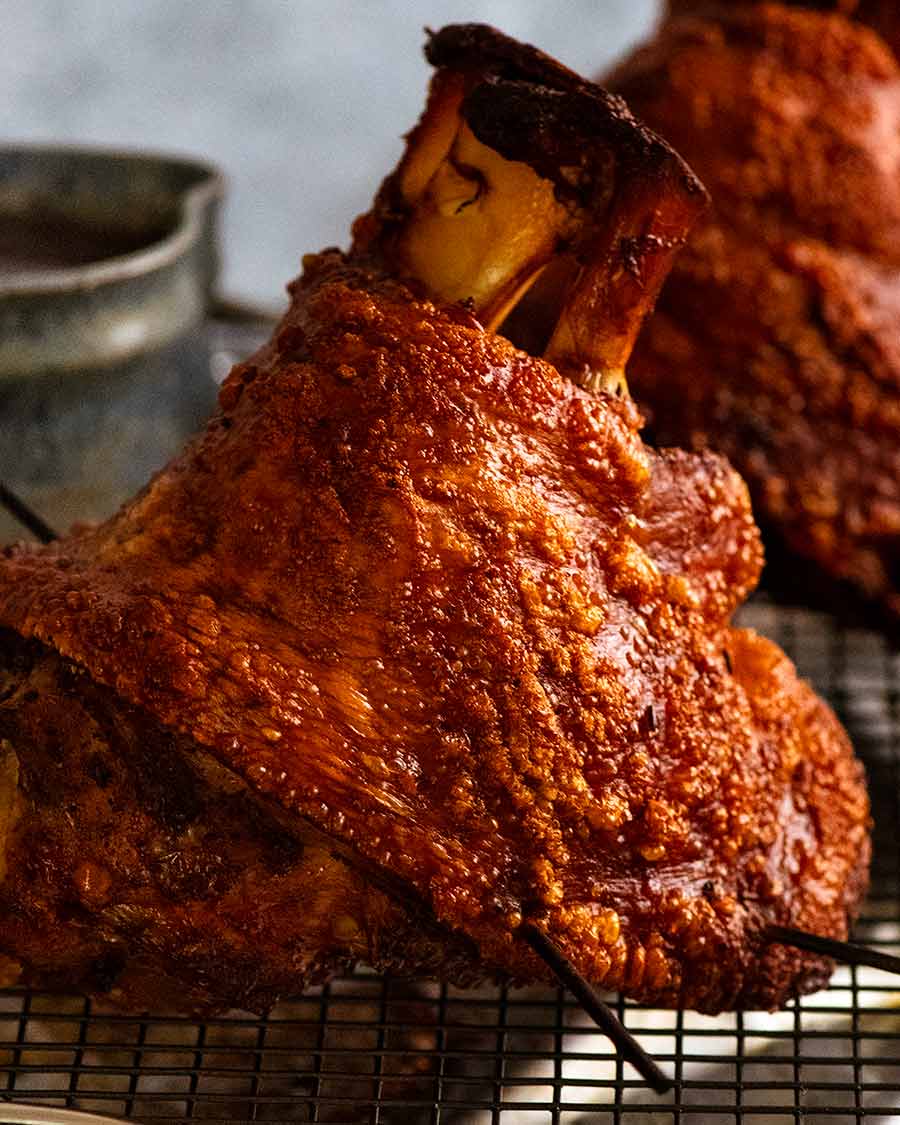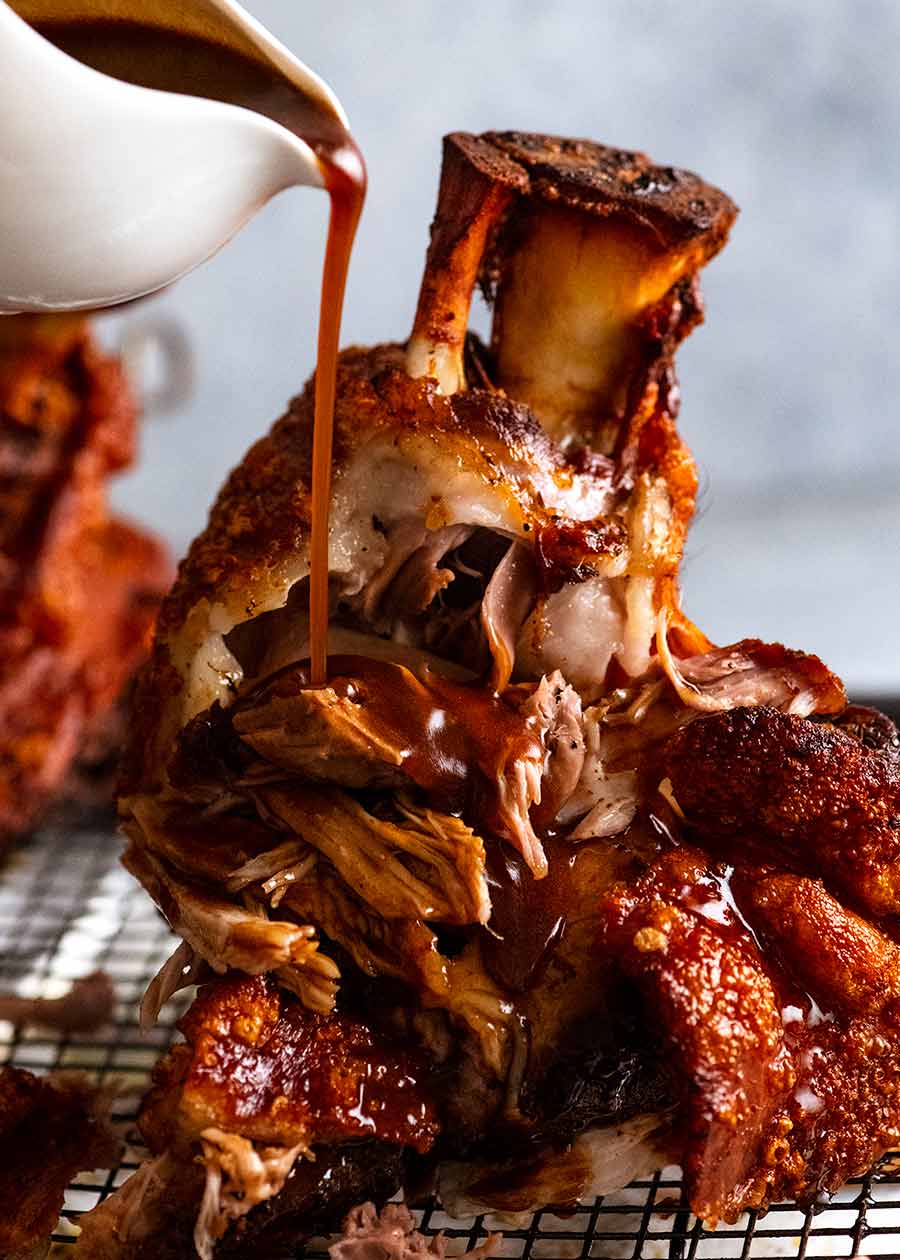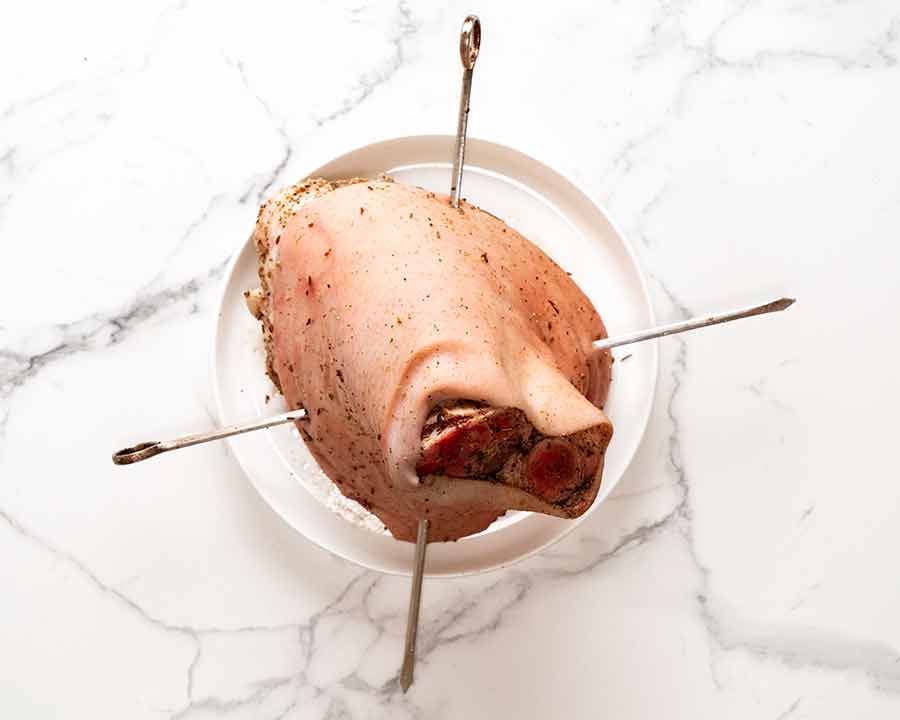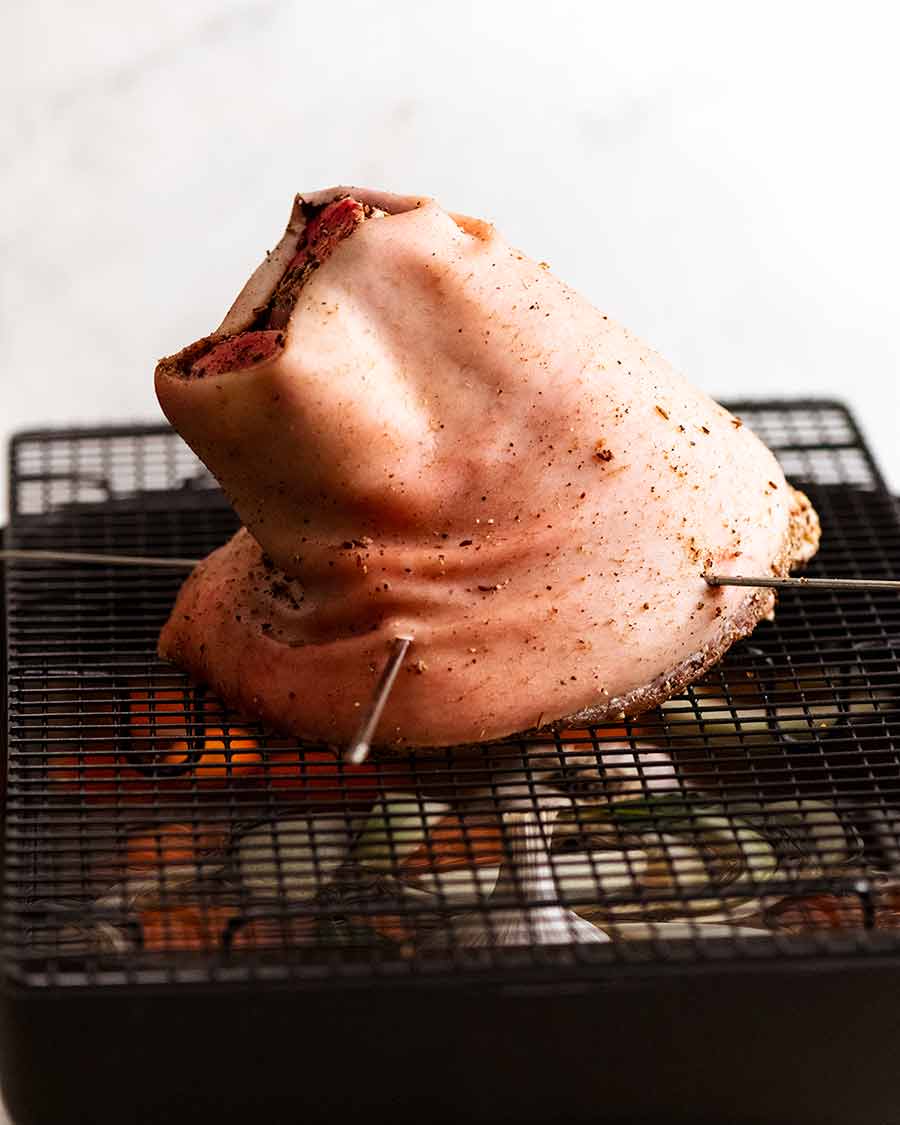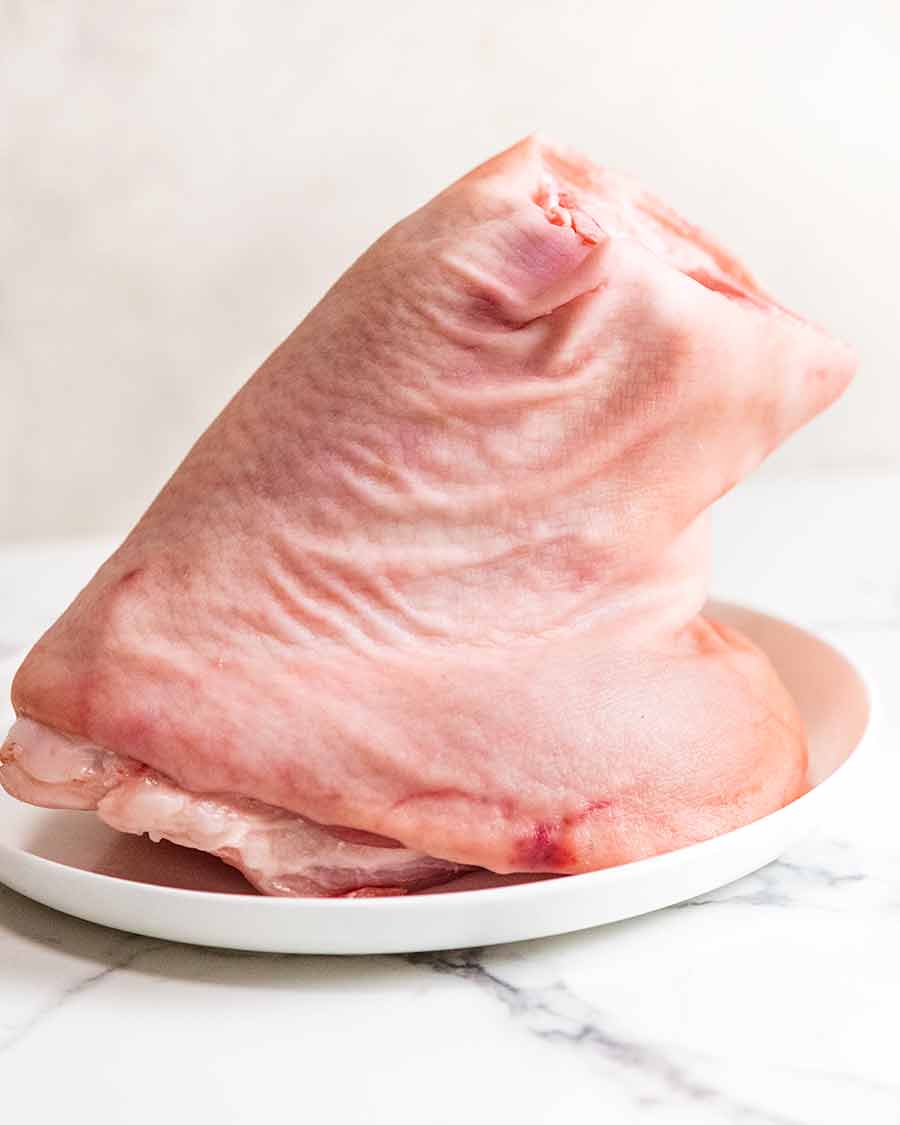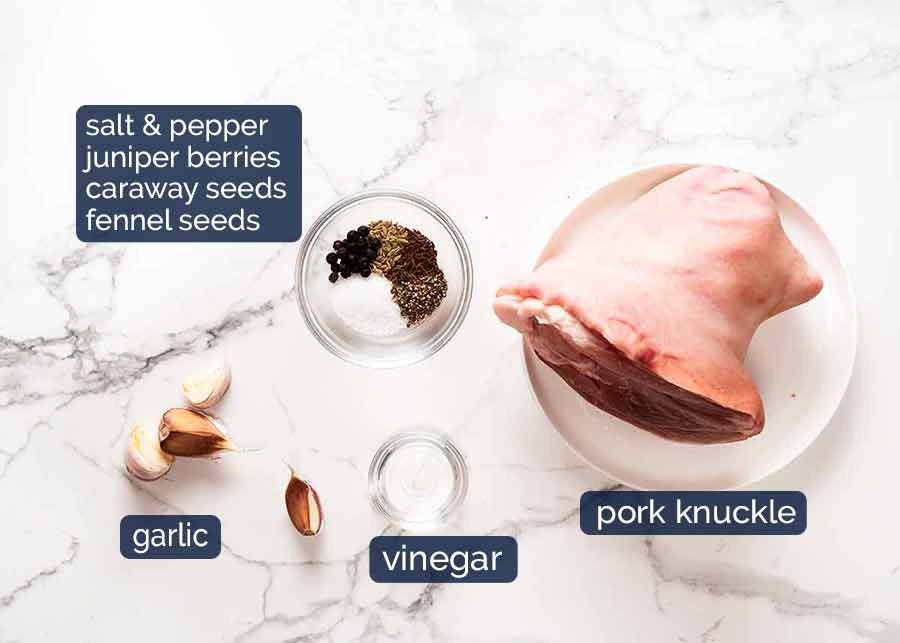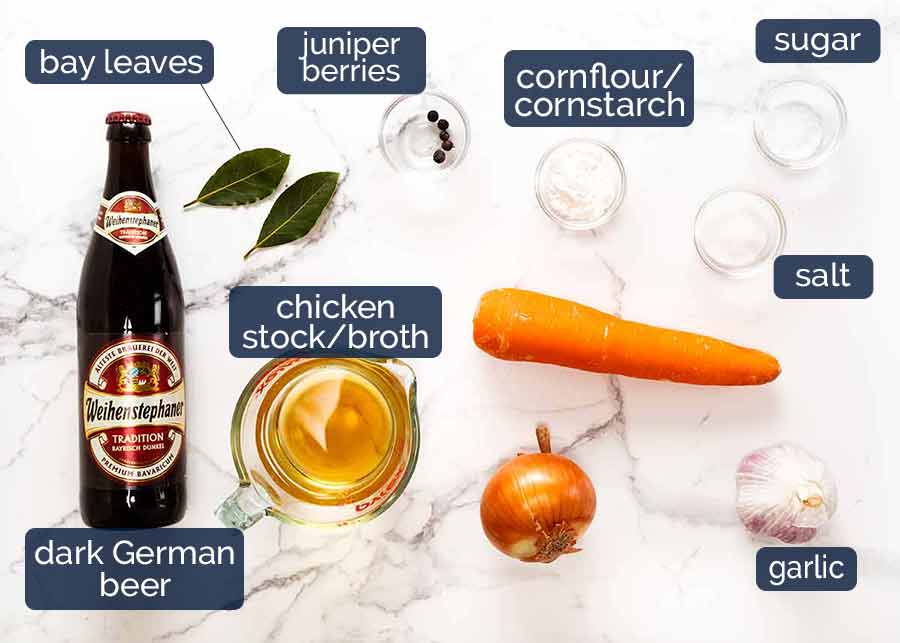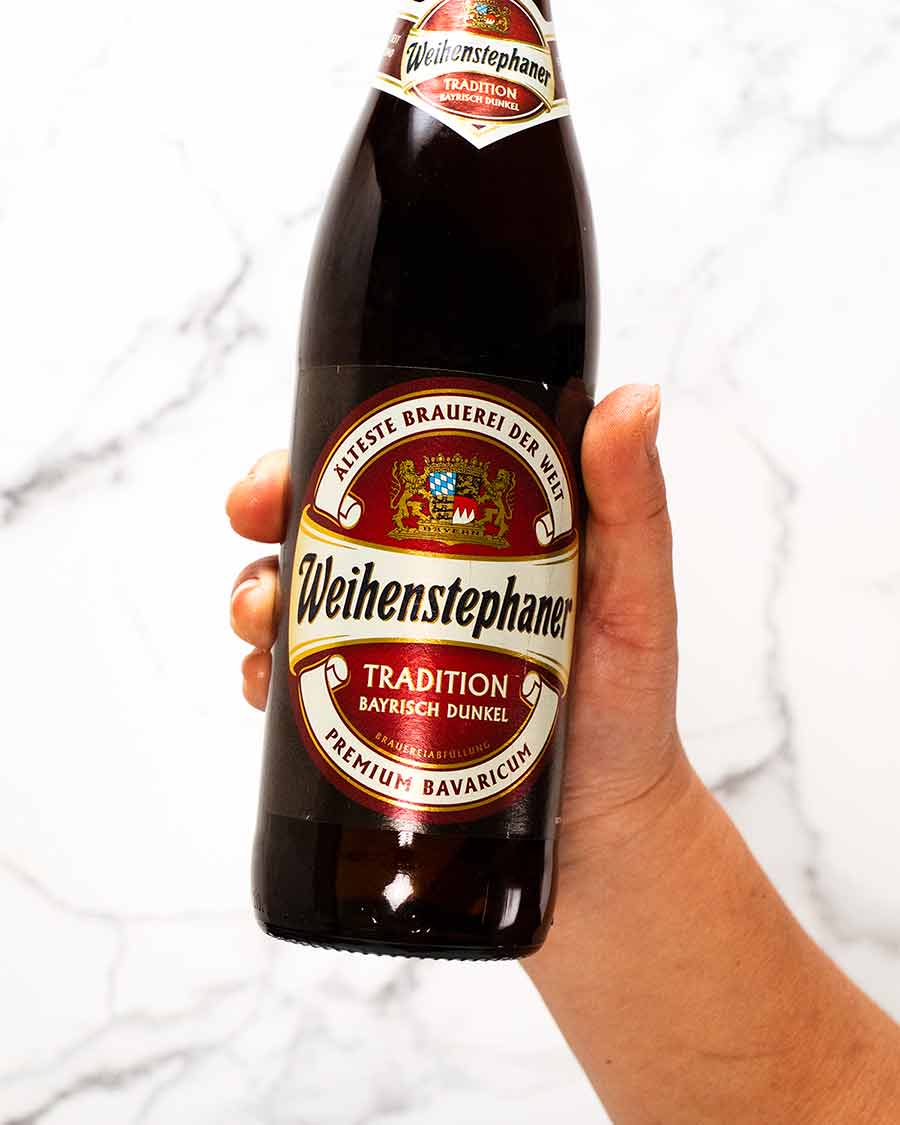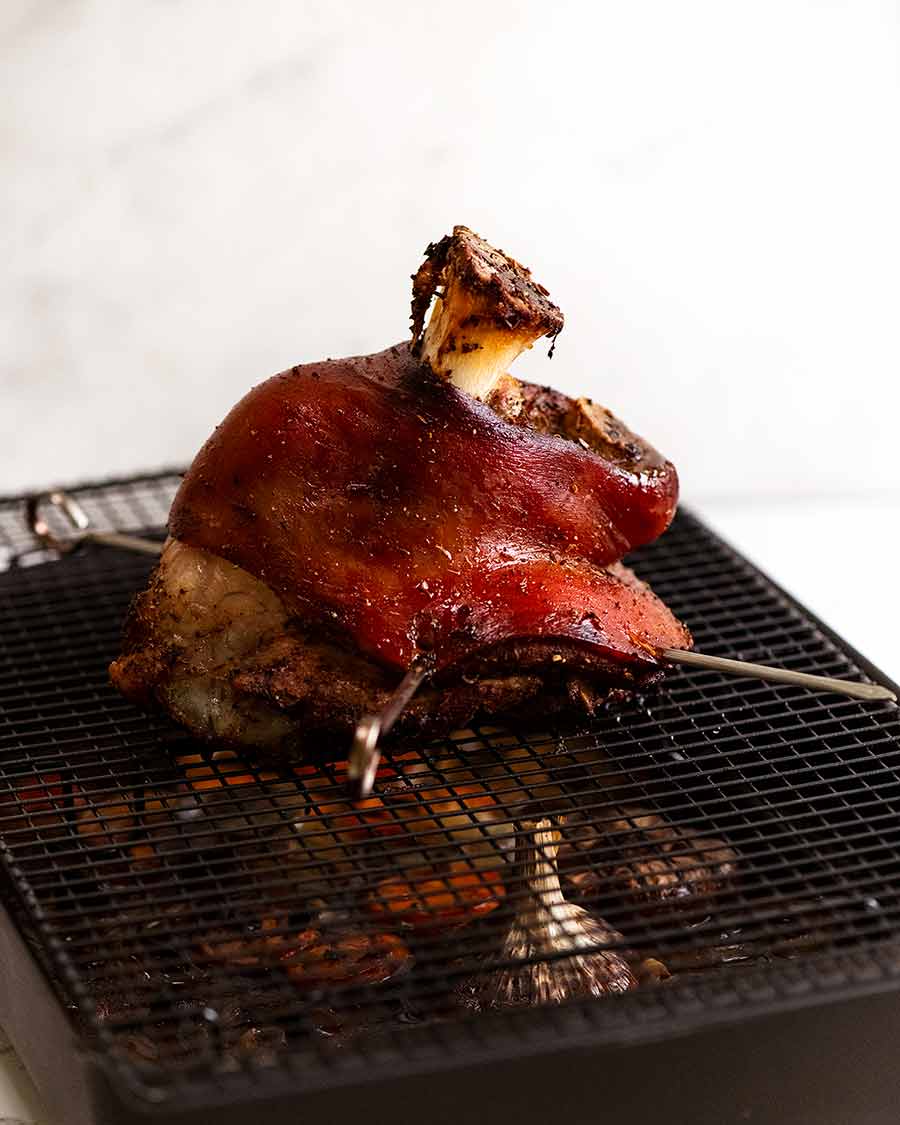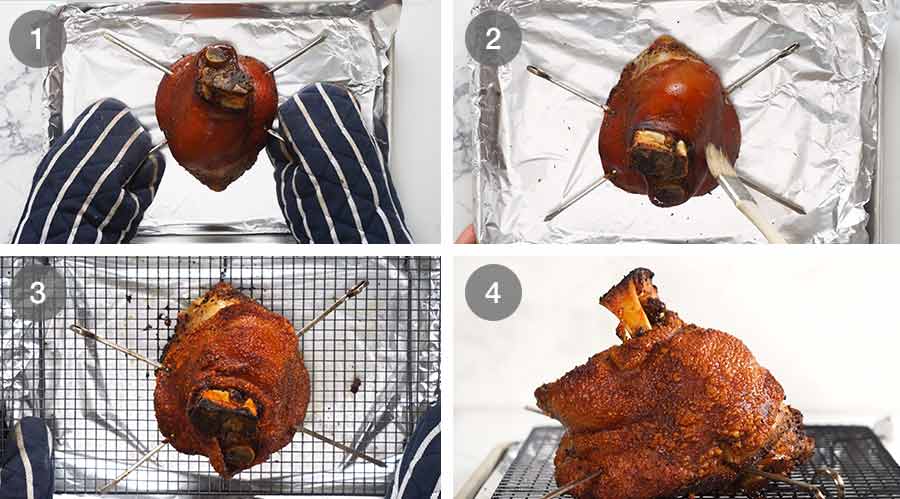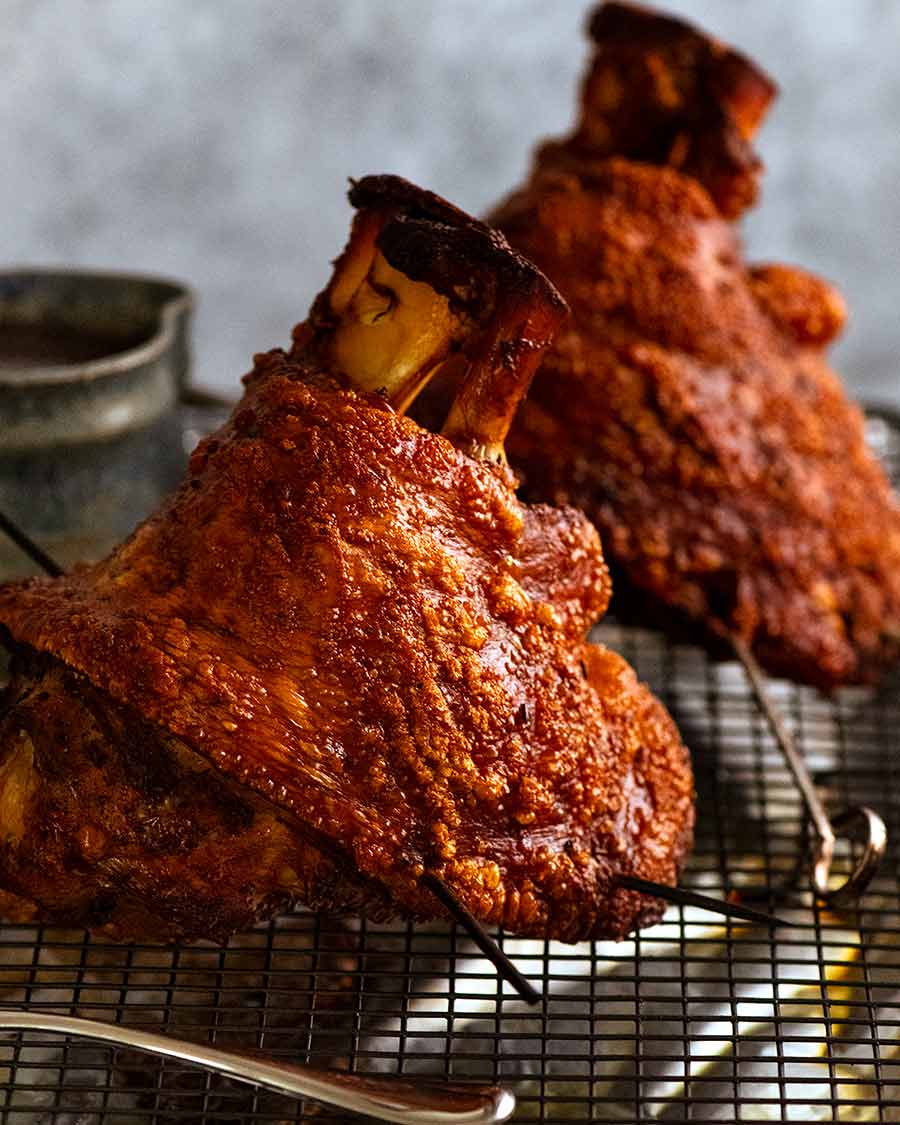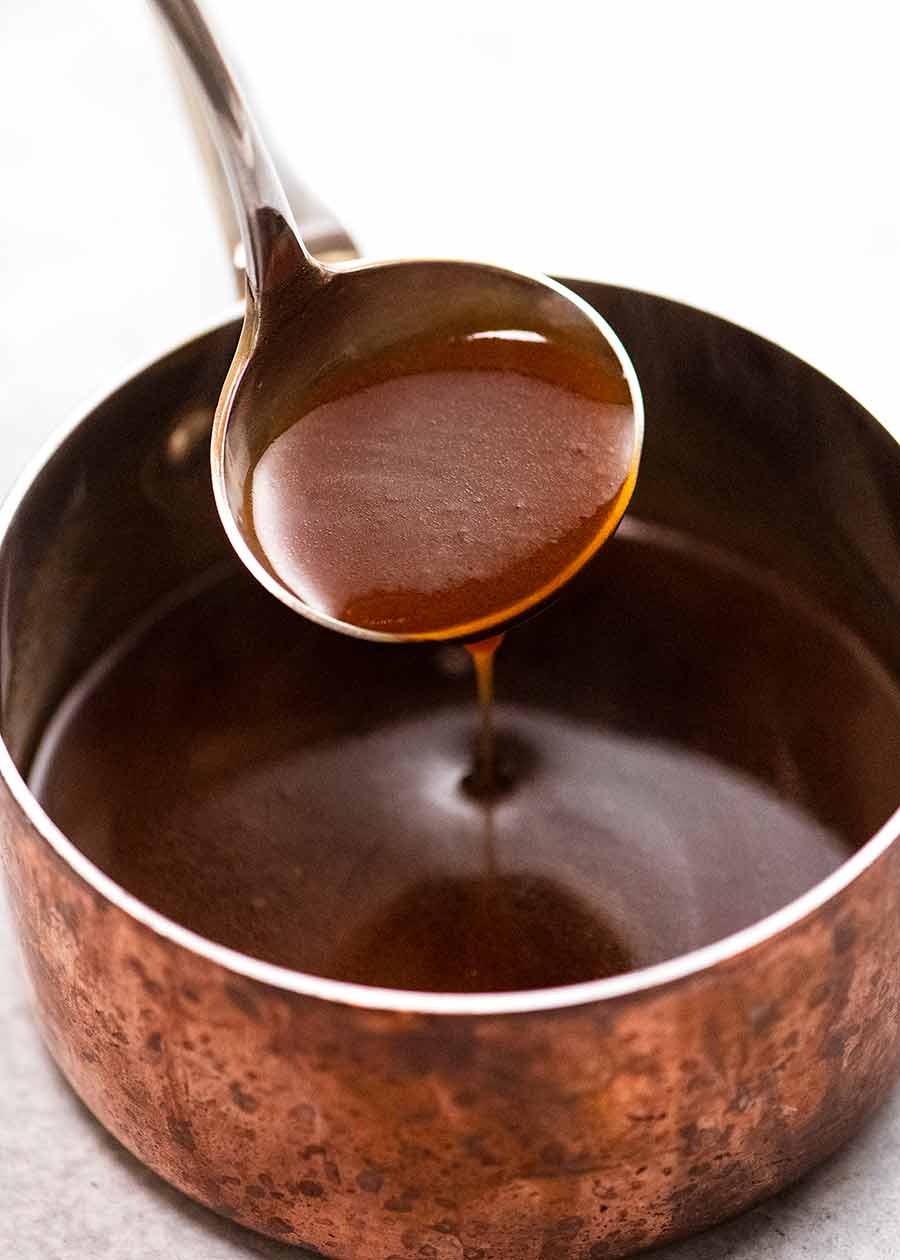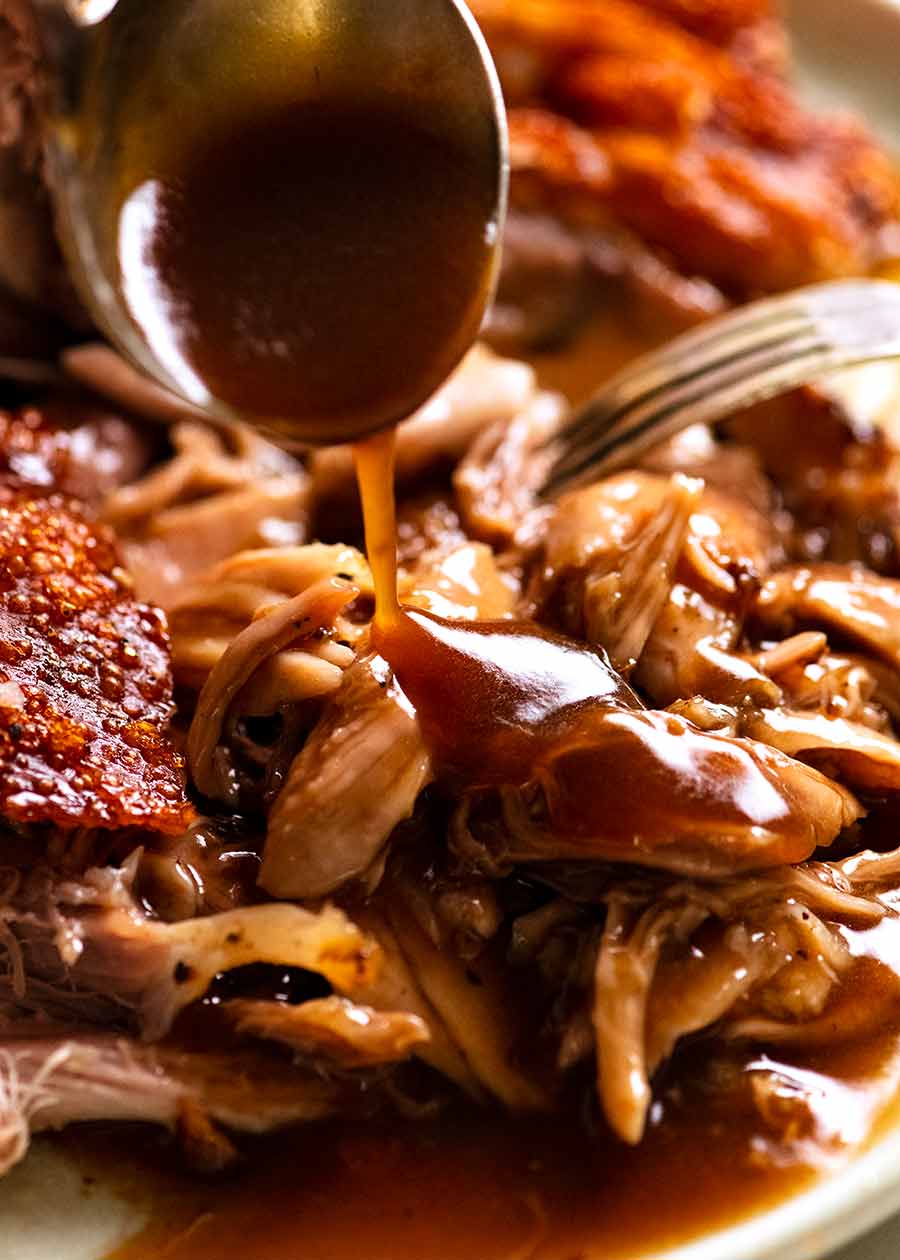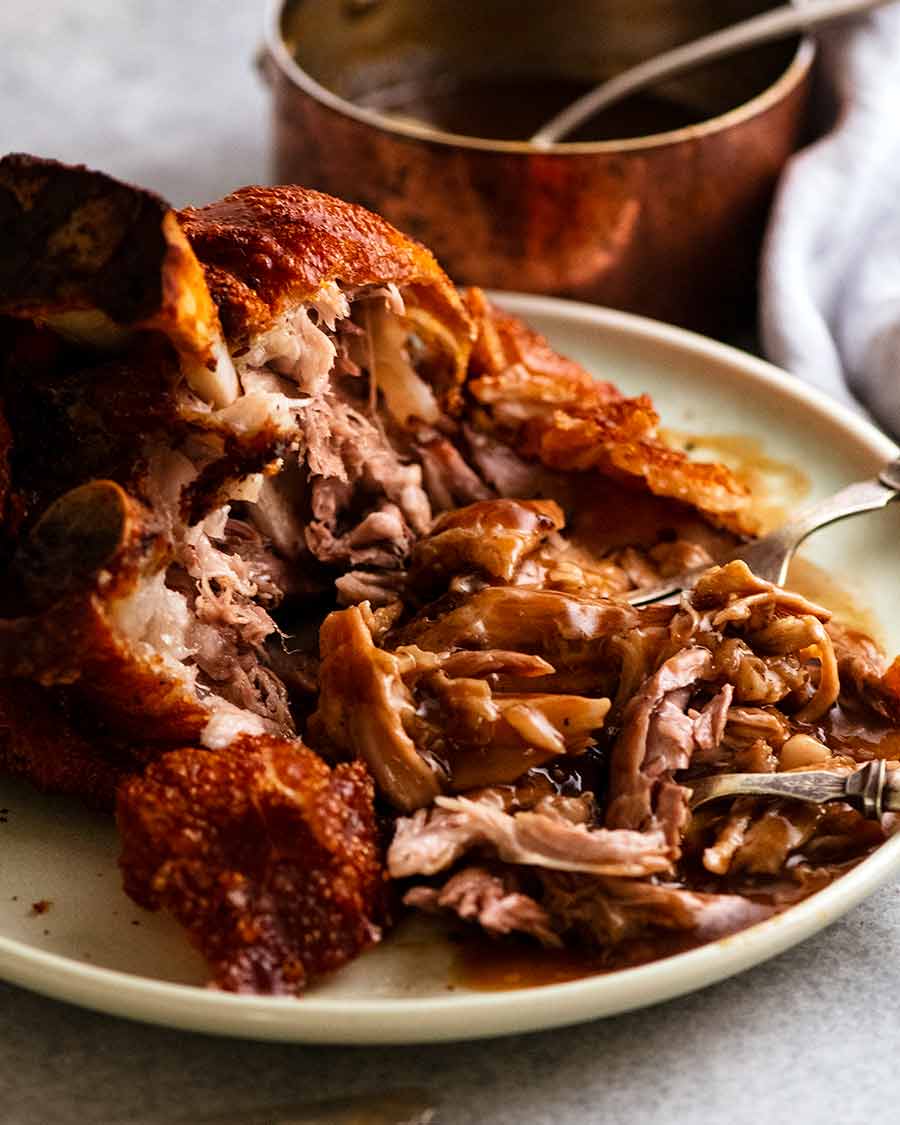Of the many things Germans have perfected, pork roast is right up there. And key to this meaty art is of course amazing crackling, something most recipes fall short on with Pork Knuckle … but we cracked the code!
German Pork Knuckle (Schweinshaxe)
Pork Knuckle – sometimes called Pig Knuckle – is as Bavarian as Oktoberfest, lederhosen and BMW. Called Schweinshaxen, these mighty hunks of roasted pork hock are a fixture of pubs and beer halls in Munich and this part of Germany, as well as nearby Austria. Always served in a puddle of dark and malty beer gravy, Pork Knuckle is loved by Germans for its juicy, lip-smackingly rich meat on the bone, all wrapped in a sheath of golden crackling that shatters under a knife. Don’t let appearances fool you! Pork Knuckle might not win many beauty pageants (except maybe in the eyes of a Bavarian! 😂) but one taste is all it takes to fall head over heels for this German classic. And once you have, nothing else ever goes down quite as well with a giant stein of cold German beer!!
The challenge: How to make crispy skin on Pork Knuckle
While producing deliciously tender meat in German Pork Knuckle is straightforward enough, very rarely do you see a Pork Knuckle fully encased with really good crackling. I mean the properly bubbly skin, the stuff that shatters delightfully into a thousand porky shards under the teeth. Not the rock-hard and flat sort of crackling where it’s your teeth more likely to be shattering! It’s the shape of the pork knuckle that makes it hard to get perfect crackling all over. Crackling is easy enough when the skin is level and flat as in pork belly and shoulder, due to even heat distribution. With Pork Knuckle, the skin is wrapped around the bone and oriented vertically. This means two things. Firstly, due to height and thus temperature difference in the oven, the top and bottom skin areas of the knuckle are harder to cook evenly. Secondly, the skin shrinks as it roasts, causing creases and folds which never turn into good crackling.
So how do you get perfect crispy crackling for Pork Knuckle?
Here’s how:
Ingredients for Crispy German Pork Knuckle
1. Pork knuckle
First up, you need to get your hands on a pork knuckle. Here is what it looks like: Firstly, pork knuckles are not pig’s trotters (feet)! Despite the name, it is actually the meaty upper part of the pig’s leg. Pork knuckle is variously known as pig knuckle, pork shanks, pork hock and ham hock (though this also refers to smoked or cured hocks). For German Pork Knuckle, we specifically need the rear leg knuckles / hocks because they are much bigger and meatier. Pork knuckles / hocks cut from the front legs of a pig are smaller and often smoked to make smoked ham hocks, for dishes like Pea & Ham Soup. Note also that sometimes pork knuckles / hocks are sold brined (salted) as pickled hocks or ham hocks. Lightly brined knuckles may be suitable for this recipe, however I have not tested this. We also do not want smoked hocks. I recommend you stick to un-brined, raw pork knuckles / hocks. One pork knuckle (around 1.2 – 1.3kg / 2.6 – 2.9lb) is enough to comfortably feed two. If it’s a particularly small knuckle, it will feed one very hungry eater! Where to get pork knuckle – Here in Sydney, they are sold at some butchers though you usually need to ask for it, as they may have it out the back rather than in the counter display. However, I found it quite easy to get pork knuckle from Asian butchers. They may have it displayed or stored at the back. They are good value at around $8/kg ($4/lb)! Remember: Ask for rear leg hocks / knuckles. And show them the photo above! 😂 (Bit of food trivia for you: the reason why pork knuckles are easily found at Asian butchers is it’s a pork cut used in Asian cooking. In contrast, the pork knuckle is often part of the whole ham (leg) in Western cooking, hence why it’s not as widely available separately at Western butchers.)
2. Seasoning rub
Here’s what you need to prepare the pork for roasting:
Juniper berries, caraway seeds and fennel – These are some traditional flavourings used when seasoning the Pork Knuckle. They are easy to find these days, though juniper berries are less common in mainstream grocery stores in Australia. Aside from spice shops, they are usually carried by delis and fresh produce stores with a good selection of herbs and spices (eg. Harris Farm);Garlic – Because garlic is always welcome! These are cut into slivers and stuffed into small incisions made into the flesh of the pork; andVinegar – Vinegar is for brushing onto the flesh and skin of the pork to reduce strong pork odour that you can sometimes get roasting secondary pork cuts. It’s not a step you see with all pork recipes, but it’s worth doing as an insurance policy. It does not make the pork taste “vinegary” at all.
3. German beer gravy ingredients
A rich, dark, full-bodied gravy flavoured with beer is the traditional sauce served with Pork Knuckle . The base of the gravy is the pan juices remaining after roasting the pork knuckle. Here’s what you need to make it: Dark German beer – The key flavouring for the gravy which also makes it a deep, dark brown colour. I used Weihenstephaner Tradition Bayrisch Dunkel which is a dark German beer (Bavarian, in fact!) sold at Dan Murphys in Australia . If you can’t find German dark beer, any dark ale, porter or stout will do (even Guinness!). Just make sure it’s a proper dark beer else the gravy will lack richness, sweetness and colour. However, avoid stouts that are too heavy and bitter, as they can be overwhelming here.
Bay leaves, carrot, onion and garlic – Typical ingredients used in homemade stocks for the flavour base, which is essentially what we’re making here!Chicken stock – For extra savoury depth in the gravy. If you don’t have any, I am confident the gravy will still have enough flavour if you just used water instead;Juniper berries – More of that fruity, spiky-tasting berry echoing the flavour in the pork rub;Salt and sugar – Seasonings for the gravy; andCornflour / cornstarch – To thicken the beer gravy. This is fairly traditional in beer gravy for a couple of reasons. Firstly, it gives the gravy a clearer finish compared to flour, which makes gravies cloudy. Secondly, we end up with a fair volume of pan liquid after the the pork is roasted since we are building a tasty stock under it as it roasts. This is different to the roasted meat pan drippings like with roast lamb, roast pork etc, which lacks much liquid initially. So we need a thickener we can just stir straight into the stock to make the gravy, rather than cooking off flour in the fats of pan drippings, and then adding liquids.
How to make Crispy German Pork Knuckle
This section is a bit lengthy. Fear not: it’s actually just information rather than an indication of effort! In all honesty, once you get to the actual doing part, you’ll realise it’s actually a very low-effort recipe. 🙂 Secondly, we end up with a fair volume of pan liquid after the the pork is roasted since we are building a tasty stock under it as it roasts. This is different to the roasted meat pan drippings like with roast lamb, roast pork etc, which lacks much liquid initially. So we need a thickener we can just stir straight into the stock to make the gravy, rather than cooking off flour in the fats of pan drippings, and then adding liquids. Here’s a rundown of how I’ve broken this section up:
Part 1: Preparation & seasoning
Firstly, preparing the pork and seasoning it!
Part 2: Slow-roast
Seasoning and “marinating” done, now it’s slow-roasting time to make the flesh beautifully tender! Note at this stage we just apply to the flesh. The skin will be done later during the high heat roasting step when we are crisping up the crackling! TIPS: – Position the skewers so they pass through as close to the bone as possible;– Make the point at which you pierce the skin 2cm / 0.8″ from the bottom edge of the skin. If it’s too close to the edge, it might tear as it roasts;– No metal skewers? Use wooden or bamboo skewers but soak them for 1 hour in water beforehand which will help stop them from burning in the oven. Also cut off most of the skewer excesses sticking out;
What it looks like after the initial slow-roast, before crisping skin
When you pull the pork knuckle out of the oven after this initial slow-roast, the skin should still be soft and rubbery, but very dry. The skin needs to be soft at this stage in order for the pork crackling bubbles to form when we put it back into the oven at a very high temperature. If the skin is crispy at this stage, those lovely bubbles can’t form and it’s game over! 😩 This setup achieves two things. Firstly, the steam rising from the liquid keeps the underside flesh nice and moist without affecting the crispiness of the skin (the angle of the sloped knuckle skin is such that it doesn’t get directly hit with steam). And secondly, the meat juices drip down into the pan which adds lots of meaty flavour into the stock we’re building for the beer gravy. Win, win, win! Having a meat thermometer really helps here to achieve the ideal cook time for the flesh. Pork knuckle meat is actually not that fatty or uniformly rich with connective tissue, so if you cook it excessively it can begin to lose juiciness in parts. It is still much more forgiving than lean pork cuts such as tenderloin, where dryness sets in quickly if you do cook it for longer than necessary. But it is not as forgiving as, for example, pork shoulder or pork belly, where you can go considerably over the required cook time and the flesh will still be juicy. In short, it’s best to use a meat thermometer! I have a Thermapen – more on that cool gadget here. This is what it should look like after the first cooking stage:
Part 3: Make that Crispy Pork Knuckle crackling!
- There is just no other way to describe how a pork knuckle should be eaten! The liquid in the roasting pan at this stage should be reduced, and just needs to be thickened to make the Beer Gravy – see Part 4 below; Don’t worry! Brushing with vinegar doesn’t affect the crispiness of the skin. We only brush on a bit and the high heat of the oven evaporates it quickly; But we get darn close, and I reckon better than anything I’ve seen out there! Now rest the pork for 15 minutes to allow the juices in the meat to redistribute. If you skip this step, then the meat juices will just run everywhere when you start ripping* into the meat! Don’t forget that jug of German beer gravy! See below for steps for how to make it.
Part 4: German beer gravy
While the skin is crisping up in the oven into crackling perfection, make the beer gravy:
– If you’re short on liquid, the gravy will be too thick so we can just add water to increase the volume;– If you have too much liquid, the gravy will be too thin so simmer the gravy for longer to reduce and concentrate; Aim for around 1.5 – 2 cups, but aim for gravy thickness as your guide for the right quantities. And taste, of course! Then just simmer for 2 minutes until it becomes a thin syrup consistency. Beer gravy for Pork Knuckle is not supposed to be as thick as English-style gravy like you serve with roast pork or roast lamb. See above for adjusting thickness as required. Pour gravy into a jug and serve alongside the pork knuckle. Or, plate it the traditional way by firstly pouring a big pool of gravy into the middle of a plate, then placing the knuckle grandly on top!
How and what to serve with German Pork Knuckle
Traditionally, Pork Knuckle is often served with a hefty German potato dumpling or two. The sticky balls make the perfect stodgy vehicle (in a good way!) for mopping up that delicious gravy! On the side, you might have some sauerkraut or a slaw-like cabbage salad (similar to this one, which would make a lovely side here). Potato dumplings are beyond our scope for today, so later this week instead I will be sharing I’ve shared a German Potato Salad to go with the Pork Knuckle, as well as a refreshing sour cream and dill German Cucumber Salad that will be perfect to cut through all the sticky richness of the Pork Knuckle. And for dessert? Well it’s just got to be everyone’s favourite cherry-laced German torte, Black Forest Cake hasn’t it? 😉 Watch this space! With that, it’s over to you! Who can wait until Oktoberfest time to make this amazing roast?? Not me, that’s for sure!! – Nagi x
Watch how to make it
Life of Dozer
He can’t read…🤷🏻♀️
